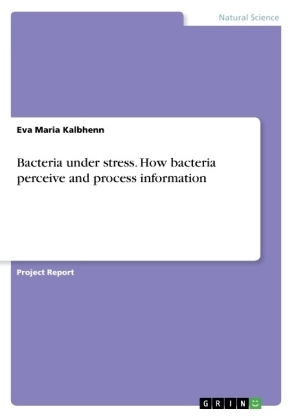
Bacteria under stress. How bacteria perceive and process information
Seiten
2017
GRIN Publishing (Verlag)
978-3-668-52308-1 (ISBN)
GRIN Publishing (Verlag)
978-3-668-52308-1 (ISBN)
- Titel ist leider vergriffen;
keine Neuauflage - Artikel merken
Project Report from the year 2014 in the subject Biology - Micro- and Molecular Biology, grade: 2.0, LMU Munich, language: English, abstract: The analysis of stress response systems in microorganisms can reveal molecular strategies for regulatory control and adaptation. For example, external pH implicates as a signal in growing number of genetic and molecular responses in enteric bacteria like Escherichia coli. In number of cases, acid-induced gene expression functions to decrease the acidity of bacterial products in an acidic environment. Thus, enhancing the growth at a low pH.In this experiment, we examine the gene expression of the E. coli cadBA operon.The cad operon consists of the enzyme CadA, which is a lysine decarboxylase, the transport protein CadB and the regulatory protein CadC.The cad operon is active when there is a low pH and lysine in the periplasm of bacteria cells. The pH sensor CadC, which is located in the periplasm, recognizes the low pH and lysine. As a result, DNA can bind and activate the transcription, so that there can be an expression of the two downstream genes cadB and cadA. Furthermore, the CadA enzyme helps to produce cadaverine. The reaction of lysine to cadavarine effectively consumes protons (H ) and lead to an increase of the internal pH. Moreover, the antiporter CadB imports the substrate lysine and exports its product cadaverine. Together, they reduce the intracellular H concentration.CadC is a member of the ToxR family and can measure the external amount of cadaverine. CadC consists of a sensor domain which is monitoring the extracellular pH and cadavarine; a transmembrane domain which interacts with LysP (Co-sensor for lysine) and the effector domain, which is a DNA-binding domain. CadC can inhibit the transcription of CadA. When the amount of cadaverine increases in the bacterial cell, the cad operon switches off of producing cadaverine by a signalling molecule called ppGpp. Under acidic conditions, ppGpp can bind to CadA and stop the cadaverine production.In the cad-Module, there is a co-sensor for lysine called LysP which acts as an inhibitor. LysP can inhibit the production of cadaverine. But LysP can also turn into a lysine transporter.The Cad-module of the bacterial cells require at least two signals, the low pH and a high concentration of lysine. The most important effect of cadaverine is the protection against acidic stress.
| Erscheinungsdatum | 06.12.2020 |
|---|---|
| Zusatzinfo | 12 Farbabb. |
| Sprache | englisch |
| Maße | 148 x 210 mm |
| Gewicht | 60 g |
| Themenwelt | Naturwissenschaften ► Biologie ► Allgemeines / Lexika |
| Naturwissenschaften ► Biologie ► Mikrobiologie / Immunologie | |
| Schlagworte | Bacteria • Cad-module • E.coli • Membrane • Mikrobiologie (nicht-medizinisch) • One-component-system • qPCR • Stress • transcriptional regulation • Transcriptionalregulation • Uptake |
| ISBN-10 | 3-668-52308-8 / 3668523088 |
| ISBN-13 | 978-3-668-52308-1 / 9783668523081 |
| Zustand | Neuware |
| Haben Sie eine Frage zum Produkt? |
Mehr entdecken
aus dem Bereich
aus dem Bereich
Über hybride Mineralien, Tiere, Pflanzen, Pilze ...
Buch | Hardcover (2023)
Matthes & Seitz (Verlag)
CHF 39,20
Band 2: Elektrizität, Optik und Wellen
Buch | Softcover (2022)
Wiley-VCH (Verlag)
CHF 55,85
Berufsbilder von und für Biologen und Biowissenschaftler
Buch | Softcover (2024)
Verband Biologie, Biowiss. u. Biomedizin in Dtl. e.V. (Verlag)
CHF 23,50


